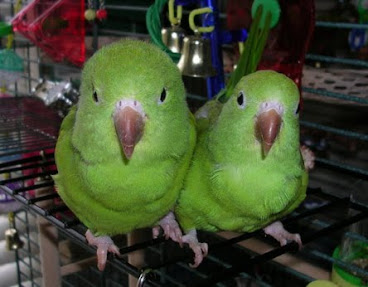Parakeet Breeding
>> Tuesday, February 23, 2010
Parakeet Breeding
Its been a long time which I visited this blog of mine because I am very busy in the past few months doing and taking care of all the things I need to do in my hobby or should I call it business which is breeding parakeets. as of now I have almost 150 pairs of parakeets being bred in our back yard. i have also different bird species that I started to breed like Parrots, African Grey, Finches, English Budgies and Macaws. I really enjoy birds. In breeding parrots, and other big species of birds, it requires time and lots of money. Time, just like the other species they need time to ensure they safety. Money, it is quite expensive in breeding parrots and other big species of birds compare to small species. They need big cages, big food container, lots of foods, they need bigger toys and they need more space to stretch their wings and fly too. In small species it is less expensive.
The best method in breeding parakeets is to raise them in pair. Put one pair in cage, the minimum measures are 45x40x35 (width, height and depth), now if it can be a bit bigger the better. Breeding pairs to avoid conflicts over nest boxes that are common in the farming community, they can usually get to the death of a full clutch, another point is to prevent dominant males are those who step on most of the females and lose control of the chicks for future cross.
The parakeet reproduction is easy, we put a nest box 20x12x12 (W, D, H) with a circular hollow inside where the female will lay between 3 and 6 eggs, normal is 5, then 6 to 9 days after the first step on the male to the female, put 1 egg every other day, the incubation takes 20 days (approx.), the eggs hatch one by one, where we notice a considerate size difference between the first and last. we must monitor the nest box and also we clean them, throw them a good bit of sawdust so that feces are mixed and not to stick it to the box and legs, it can even lead to deformity. Take about a month to leave the nest and a little more than a week to win independence. If you do not remove the nest box parakeets be played all year, I would retreat to the nest boxes in winter itching for 2 months to rest and recover, some couples manage to get 4 broods during this period.
Parakeets nest with babies, we see the age difference between them is 2 and about to leave.
Most of the food of parakeets is a seed mixture that consists mainly of millet, millet, oats, peeled, wonder (sunflower seeds) and accompanied by sprouts, leaves of spinach, lettuce and grass, some like the Apple the biscuit as a reward.
Both cage have drinkers, feeders and nest boxes which can be purchase in your local pet stores in your area, the ideal is to have metal cage that is safer because parakeets are very naughty and they cannot gnaw it. in a wooden cage they can make a hole and run away, besides it is easier to clean and is less chances of germs and bacteria to grow in.



